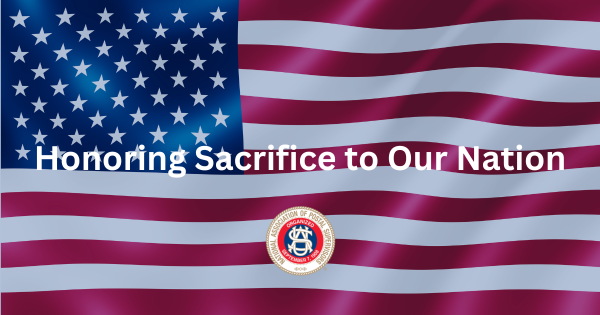Honoring Sacrifice to Our Nation
Honoring Sacrifice to Our Nation
By Chuck Mulidore
NAPS Executive Vice President
As we approach our annual Legislative Training Seminar (LTS) in Arlington, VA, April 6-9, I’d like to remind you that each year, as part of the LTS, we honor four NAPS members who are veterans or have family members who were or are veterans by placing a wreath at the Tomb of the Unknown Soldier at Arlington National Cemetery. This somber event is a testimonial to the thousands of NAPS members who have served in our nation’s armed forces and should be honored for their service.
The event also is a stark remind-er that service to our country in-volves sacrifice—and many have made the ultimate sacrifice, as is reflected in cemeteries across our country, as well as cemeteries in far-off lands. That sacrifice is never more evident than at Arlington National Cemetery and, particularly, the Tomb of the Unknown Soldier.
But just how did this hallowed ground come into being? How did the idea for a memorial honoring un-known, but not forgotten, deceased servicemen come about? As relayed by Arlington National Cemetery Tours, the idea of the tomb itself was initially inspired by the multitudes of unknown dead amassed by the end of World War I. On Memorial Day in 1921, four unknowns were exhumed from an American cemetery in France.
The four were placed in identical caskets and stationed before a highly decorated World War I veteran tasked with selecting just one of the caskets for burial in Arlington National Cemetery. That person was U.S. Army Sergeant Edward F. Younger. After the ceremonial selection was made, the body was to lie in state in the Capitol rotunda until midnight on Nov. 10, 1921.
On the following day, Armistice Day, the casket was placed in a caisson and transported to Arlington National Cemetery. Since that time, servicemen from World War II, Korea and Vietnam have been transported for burial at the Tomb of the Unknowns.
The sarcophagus built above the tomb of the soldier who served in World War I sits in front of the three marble slabs that identify the crypts of the soldiers from World War II, Korea and Vietnam. It was constructed in 1931 out of seven large marble panels collectively weighing 79 tons. On one side is a relief of three Greek figures each representing Peace, Valor and Victory.
On the other side, there are sculpted six inverted wreaths, each representing a major campaign from World War I. The U.S. Army regiment entrusted with tending to and guarding not just the Tomb of the Un-known Soldier, but also the coordination and execution of any and all burials that take place in Arlington National Cemetery, is the 3rd Infantry, affectionately known as the “Old Guard.”
For those select few who answer the sacred call to become a Tomb sentinel, it is a responsibility that is taken with the utmost grace. If there is one reason, be-sides paying their respect and the historical significance of the grounds, that visitors from all over the world visit Arlington National Cemetery, it is to witness the iconic changing of the guard. Since April 6, 1948, the Tomb of the Unknown Soldier has been guarded 24 hours a day, 365 days a year without exception. Every hour during winter and every half hour during the summer and daylight hours, one guard relieves another from their post.
This year, NAPS once again will honor members who served our country by placing a wreath at the Tomb of the Unknowns in remembrance of those who gave the ultimate sacrifice yet whose names are lost to history. On the west panel of the tomb are inscribed the words, “Here Rests in Honored Glory an American Soldier Known but to God.”
I hope you can join us at this year’s Legislative Training Seminar and help us honor that sacrifice.
